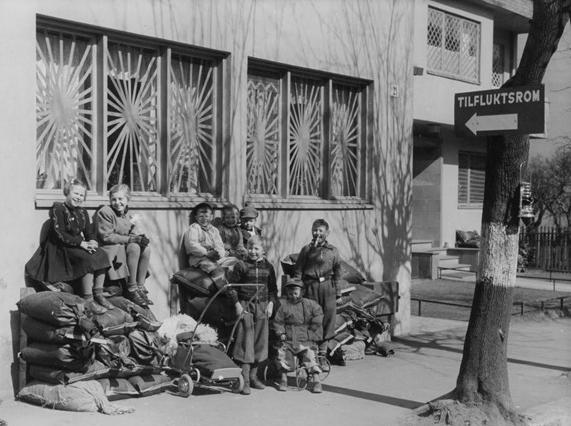
World War II Norway: Air Operations (1940-45)

Figure 1.--Here we see some Norwegian children sitting on sandbags outside an Oslo air raid shelter (tilfluktsrom). Notice the taped windows. We do not believe this was a real bomb shelter, but only a substantial building. The photograph was dated August 1940, a few months after the Germans seized Norway.
|
|
Norway was involved in the air war from the very beginning that the Germans invaded, ending Norway's neutrality (April 1940). Germany did not have a land border with Norway. King Haakon and his minister thaough that they were protectedby distance and neutrality. Thus the initial assault force had to be conducted by air and sea. This limited the German assault. The Luftwaffe assembled more than 500 aircraft for the campaign in Scandinavia, including 300 medium bombers and 50 Stuka dive-bombers. The Germans bombed Norwegian cities. The German ambassador to Norway, Curt Bräuer, met wih King Haakon and presented the German demands, incluing appoiting Quisling prime minister The King refused and told his Council that he would rather abdicate. The Germans reacted by bombing Nybergsund, the village where they believed the King was located. They were right, but the King left when he heard the the drone of appoaching bombers. From a snow covered wood he watched the Luftwaffe obliterate the village. This left no dount if any remained in the King's mind as to the character of the Germans. As the Norwegian Army was so limited and the Norwegians depending on neutrality made no real preparation, the Germans were able to pull it off. Luftflotte 5 was responsible for German air operations during the invasion and for the opperationd from occupied Norway from there after. With the onset of the Battle of Britain, Luftflotte 5 was assigned to attack northern Britain (August 1940). This did not work out well. Britain's Chain Home Network detected the first attack conducted by 65 Heinkel 111s and escorted by the long-range ME-110s. The ME-110 was Göring's pet project, but so poorly designed that it was the only fighter of the War that needed their own fighter escorts. The German commanders had thought that the bombers could hit coastal instalations and return before the British could scramble their fighters. The RAF figters scrambled by the Chain Home system savaged the bombers and their poorly designed escorts. The Germans did not come again in force. The Royal Norwefian Air Firce (RNAF) Norway had only a small, largely obsolate air force before the war. Some air crews escaped to Britain and Finland. The British helped train a new force in Canada during the War. The Norwegian training center known as 'Little Norway' was established next to Toronto Island Airport, Canada (autumn 1940).
RAF 330 (Norwegian) Squadron was activated at Reykjavík, Iceland (May 1941). They performed anti-submarine and convoy escort duties using aircraft ordered, but not delivered before the Germn invasion. The RNAF became aeparate force (1944). Luftflotte 5 after Hitler launched Barbarossa (June 1941) was shifted north and played a major role along with Kreigsmrine surface and U-boat units in efforts to stop the Allied Arctic convoys delivering supplies to the Soviets. As the War progressed, Luftflotte 5 took on a more defensive roles when the Allies began bombing Norwegian targets. These were primarily the Heavy water facilities (Tungtvassaksjonen), Kreigsmarine vessels and facilities, and German shipping from Norwgian ports. A major target became the German capital ships that hid in Norwegan fjords, protected by Luflotte 5 and anti-aircraft guns. Operation Catechism managed to sink the much feared Tirpitz (November 1944). At the end of the war, the Germans devestated an allied force attacking a rare surviving German destroyer (February 1945).
CIH -- WW II

Navigate the CIH World War II Section:
[Return to Main World War II Norwegian page ]
[Return to Main World War II German Invasion page ]
[Return to Main World War II country page ]
[Return to Main World War II displaced children page]
[Return to the Main World War II page]
[About Us]
[Aftermath]
[Biographies]
[Campaigns]
[Children]
[Countries]
[Deciding factors]
[Diplomacy]
[Geo-political crisis]
[Economics]
[Home front]
[Intelligence]
[POWs]
[Resistance]
[Race]
[Refugees]
[Technology]
[Totalitarian powers]
[Bibliographies]
[Contributions]
[FAQs]
[Images]
[Links]
[Registration]
[Tools]
[Return to Main World War II page]
[Return to Main war essay page]
[Return to CIH Home page]
Created: 12:26 AM 5/7/2016
Last updated: 12:26 AM 5/7/2016



